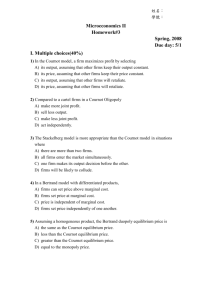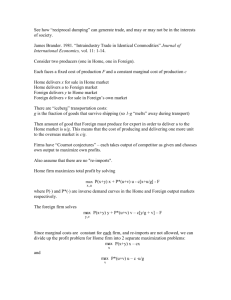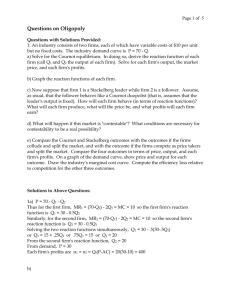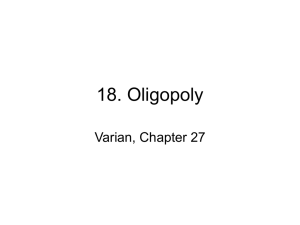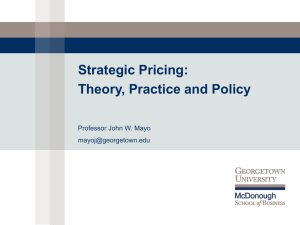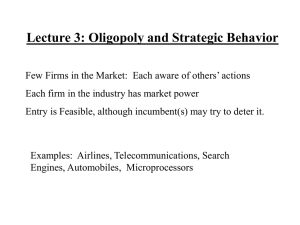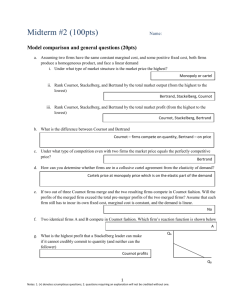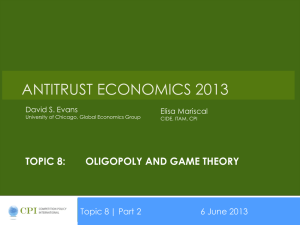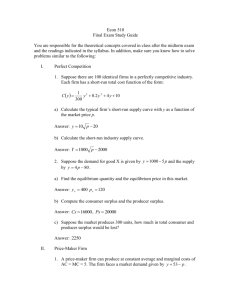GAME THEORY
advertisement
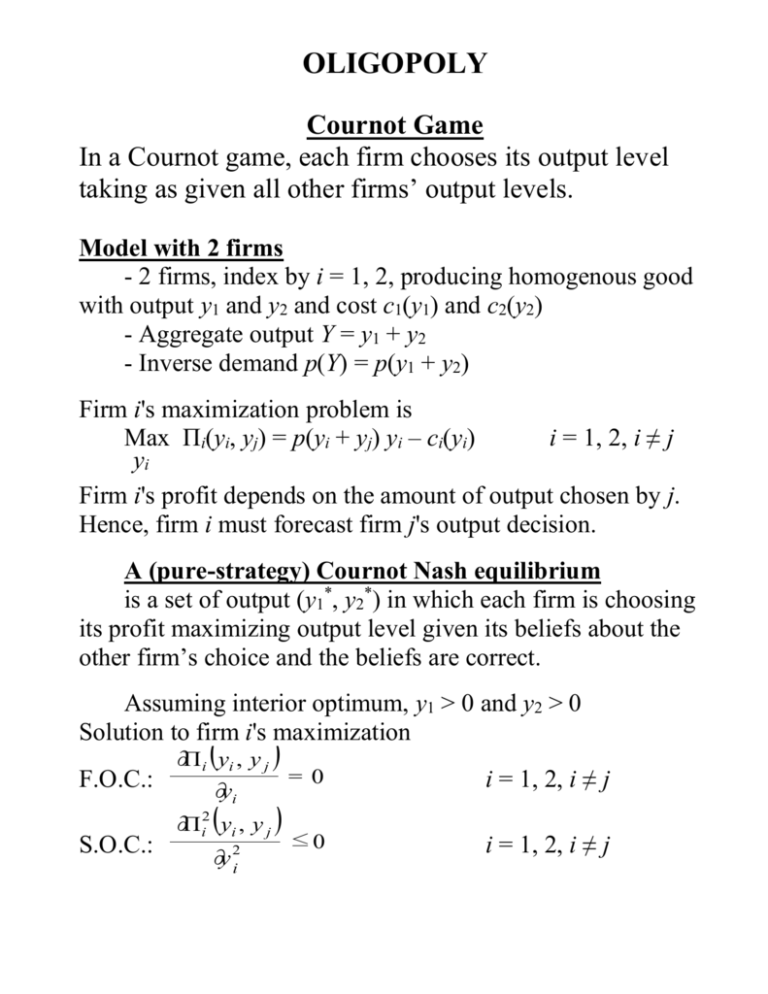
OLIGOPOLY
Cournot Game
In a Cournot game, each firm chooses its output level
taking as given all other firms’ output levels.
Model with 2 firms
- 2 firms, index by i = 1, 2, producing homogenous good
with output y1 and y2 and cost c1(y1) and c2(y2)
- Aggregate output Y = y1 + y2
- Inverse demand p(Y) = p(y1 + y2)
Firm i's maximization problem is
Max Пi(yi, yj) = p(yi + yj) yi – ci(yi)
i = 1, 2, i ≠ j
yi
Firm i's profit depends on the amount of output chosen by j.
Hence, firm i must forecast firm j's output decision.
A (pure-strategy) Cournot Nash equilibrium
is a set of output (y1*, y2*) in which each firm is choosing
its profit maximizing output level given its beliefs about the
other firm’s choice and the beliefs are correct.
Assuming interior optimum, y1 > 0 and y2 > 0
Solution to firm i's maximization
F.O.C.:
S.O.C.:
(
∂
Π i yi , y j
∂
yi
(
∂
Π i2 yi , y j
∂
y 2i
)
)
= 0
i = 1, 2, i ≠ j
≤0
i = 1, 2, i ≠ j
From F.O.C.s, we get each firm reaction curve (best response
function). Reaction curve gives firm i's optimal output as a
function of its beliefs firm j's output choice.
Denote the reaction curve of firm i by fi (yj),
from F.O.C., we write
(
∂
Π i f i ( y j ), y j
∂
yi
)
≡0
To see how i changes its optimal output level as its belief
about firm j's output changes, differentiate the above w.r.t. to
yj
(
∂
Π 2i yi , y j
∂
y 2i
)
f i′
(yj) +
(
(
∂
Π 2i yi , y j
∂
yi ∂
yj
Π 2i yi , y j
f i′
(yj) =
(
)
=0
)
Π 2i yi , y j
yi ∂y j
)
y 2i
Denominator is negative due to S.O.C.
Numerator is negative if inverse demand curve is downward
(Y ) + p′
(Y ) yi < 0
sloping and not too convex such that p′
(yj) < 0
→ fi′
If the reaction curves are downward sloping, players’
strategies are said to be strategic substitutes.
If the reaction curves are upward sloping, players’
strategies are said to be strategic complements.
System of differential equations
dy1
= g1 ( y1 , y 2 )
dt
dy2
= g 2 ( y1 , y 2 )
dt
has a stable equilibrium if
∂
g1
∂
y1
∂
g2
∂
y1
∂
g1
∂
y2
∂
g2 > 0
∂
y2
and
∂
g1
∂
g2
+
< 0
∂
y1
∂
y2
Suppose the firms adjust their outputs in the direction of
increasing profits
dy1
∂
Π1 ( y1 , y 2 )
= α1[
]
dt
∂
y1
dy2
∂
Π 2 ( y1 , y 2 )
= α2[
]
dt
∂
y2
Then the equilibrium is stable if
Comparative Statics
We want to see how optimal choice (say of firm 1) is
affected if some parameter changes.
Suppose that a is a parameter that shifts П1
∂
Π1 ( y1 ( a ), y 2 ( a ), a )
≡0
∂
y1
∂
Π 2 ( y1 ( a ), y 2 ( a ))
≡0
∂
y2
by F.O.C.s
Differentiating with respect to a and using the Cramer’s rule
∂
y1
to solve for ∂
, we get
a
Several Firms
Suppose there are N firms
p(Y ) + p′
(Y ) yi = ci′
( yi )
i = 1, 2,…., N
N
where Y = ∑yi
i =1
We can write
p(Y )[1 + p′
(Y )
Y
si ] = ci′
( yi )
p
i = 1, 2,…., N
si
p(Y )[1 + ] = ci′
( yi )
i = 1, 2,…., N
ε
where si = yi/Y and ε = elasticity of market demand.
Cournot model is in between monopoly and competitive
models.
if si = 1 → monopoly
if si → 0 → competitive firms with infinitesimal market share.
Adding up all N equations, we have
N
Np(Y ) + p′
(Y )Y =
Σ ci′
( yi )
i =1
Aggregate industry output Y only depends on the sum of the
marginal costs, not on their distribution across firms.
If all firms have the same constant MC = c then the
equilibrium is symmetric si = 1/N and
1
p(Y )[1 +
] = c as N → ∞, price approaches marginal cost
Nε
Welfare
Assuming a symmetric equilibrium, Cournot induxtry
maximizes the weighted sum of consumers’ surplus and
industry profit as given by
(N-1)[U(Y) – cY] + [p(Y) – c]Y
To see this, differentiate the above with respect to Y and set
equal to 0
(Y ) – c] + p′
(Y ) Y + p(Y) – c = 0
(N-1)[ U ′
Note that U(Y) =
Y
∫
0p(x)dx
U′
(Y ) = p(Y)
Using this fact and rearrange the equation yeilds
1
p(Y )[1 +
]=c
Nε
This is the profit maximizing condition in a symmetric
Cournot equilibrium.
As N → ∞, more weight is put on the social objective of
utility minus costs, as compared to private objective of profits.
Alternatively, to maximize social objective
Wsocial(Y) = U(Y) – cY
(Y ) = p(Y) = c
F.O.C.: U ′
1
p
(
Y
)[
1
+
] = c,
However, Cournot optimization
Nε
as N → ∞, social objective is maximized.
Bertrand Game
In a Bertrand game, each firm chooses its price level taking as
given all other firms’ price levels.
Model with 2 firms
- 2 firms, index by i = 1, 2, with a constant unit cost of c1 and c2
- Products are homogeneous and the demand for firm i is
di(pi, pj) =
{
D( pi )
D( pi ) / 2
0
if pi < p j
if pi = p j
if pi > p j
where D(p) is the market demand curve
Case 1): If c1 = c2 = c, a Bertrand Nash equilibrium is
p1 = p2 = c and each firm gets half of the markets
Proof.: If p1 > c, firm 2 can set p2 = p1 – ε and get the entire
market, earning (almost) entire profit
But if p2 > c, this cannot be an equilibrium because
firm 1 will have incentive to undercut price further
Case 2): If c2 > c1, a Bertrand Nash equilibrium has
firm 1 sets p1 = c2 and gets the entire market and
firm 2 sets p2 ≥ c2 and produces zero.
Proof.:
With only 2 firms, we get the result of firms setting price =
MC, or the firm that is in operation sets its price = marginal
cost of firm with higher cost.
Differentiated Products
Inverse demand functions
of two goods that are not perfect substitutes
p1 = α1 – β1y1 – γy2
p2 = α2 – β2y2 – γy1
Measure of product differentiation γ2/ β1β2
Cournot Competition for firm i
Max [αi – βiyi – γyj] yi
yi
Direct Demand functions
y1 = a1 – b1p1 + cp2
y2 = a2 – b2p2 + cp1
Bertrand Competition for firm i
Max [ai – bipi + cpj] pi
pi
Outputs of firms are strategic substitutes
→ increasing yj makes it less profitable for firm i to
increase its output
Prices are strategic complements
→ an increase in pj makes it more profitable for firm i to
increase its price.
Quantity Leaership (Stackelberg Model)
- A sequential game with 2 stages
- First stage: Leader moves by choosing its output level
- Second stage: Follower chooses its output level after
observing the leader’s output.
Stackelberg with homogeneous products (perfect
substitutes)
Let leader = firm 1, follower = firm 2
Second stage
Firm 2 chooses y2 given y1
This is essentially reaction curve of firm 2, f2(y1) in Cournot game
First stage
Firm 1 maximizes
Revealed Preference:
The profit of the leader in Stackelberg equilibrium will usually
be higher than his profit in Cournot equilibrium.
Leadership Preferred:
A firm always weakly prefers to be a leader.
Proof.
This can be shown using the fact that with homogeneous products
i) П1(y1, y2) is a strictly decreasing function of y2 and vice versa
ii) The reaction curves f1(y2) and f2(y1) are strictly decreasing
functions
Price Leadership
- Heterogeneous products
- Demand for output of firm i = xi(p1, p2)
- 2 firms, leader = firm 1, follower = firm 2
Second stage
Firm 2 max
First stage
Firm 1 max
If goods are substitutes with high degree of substitution, we
may expect reaction curves to be upward sloping.
Following Preferred
If both firms have identical cost and demand functions and if
reaction curves are upward sloping.
→ each firm prefers to be the follower to being the leader
Intuition: Leader has to support high price by producing low
output whereas follower can set price equal to leader’s price (or
undercut leader’s price a little) and produce as much as it wants.
Capacity Constraint Game
- 1st period, each firm chooses its production capacity yi
- 2nd period, they play Bertrand game
The outcome of this game is typically a Cournot equilibrium
- The price charged at 2nd period is p(y1 + y2) which is just the
inverse demand at capacity
- Choosing capacity at 1st period is then just a Cournot game.
Conjectural Variations
If firm 1 makes a conjecture about firm 2 responds to its
choice of output, denote it by y 2v ( y1 ) and let
v12
∂
y 2v ( y1 )
=
∂
y1
v
Firm 1 max p(y1 + y 2 ( y1 ) ) y1 – c1(y1)
F.O.C.:
i) If v12 = 0
→ Cournot model, each firm believes that
the other firm’s choice is independent from its own
ii) If v12 = -1
→ Competitive model
( y1 ) = slope of reaction function → Stackelberg
iii) If v12 = f 2′
iv) If v12 = y2/y1 → Cartel
Criticism:
It is a static model but is should be a dynamic model as it is
modelling how other firms should respond.
Collusion
If firms act as cartel, they maximize the sum of profits by
choosing y1, y2,….,yN simultaneously
N
max
y1, y2,..,yN
p(Y)Y –
Σ ci ( yi )
i =1
F.O.C.:
However, the solution is not stable, there is incentive to cheat
If firm 1 maximizes its own profit at cartel’s solution Y*
If firm 1 believes that other will employ cartel output, then it
would benefit to increase its own output.
If it does not believe that other firms will set cartel output,
generally, not optimal for it to maintain cartel output either.
To make cartel possible, often use effective punishment to
deter cheating.
Repeated Oligopoly Games
Example: Punishment Strategy
- chooses cartel output as long as no one cheats
- if someone cheats, chooses Cournot output in all future
periods
Let
∏ *i be one-period profit of firm i from cartel outcome
∏ Ci be one-period profit of firm i from Cournot outcome
∏ iD be one-period profit of firm i from deviation (cheating)
Infinitely Repeated Games
Note:
i) cooperation is not part of SPE in finitely repeated game.
ii) Abreu (1986) shows that one-period punishment will
typically be sufficient to support cartel output.
Limit Pricing
Limit pricing = pricing to prevent entry
Example: Perfect knowledge
- 2 firms, incumbent and a potential entrant
- 2 periods:
1st period, incumbent sets price and quantity (observed by
entrant)
2nd period, if entry occurs, they play duopoly game, if
there is no entry, the incumbent will charge monopolist price.
Solution
If duopoly profit for entrant > 0, will enter regardless of
what incumbent does previously.
Hence, incumbent should choose monopolist price in 1st
the period.
This is because the first period price conveys no
information.
Example: Imperfect Information
- uncertainty about incumbent’s cost (entrant does not know if
the incumbent has low or high cost)
Incumbent can reveal that it is a low cost by set low enough
price at first period such that a high-cost incumbent will have
no incentive to do so.
